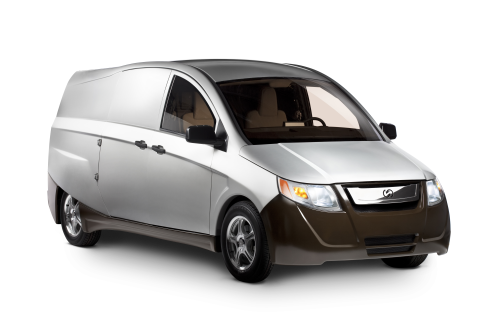
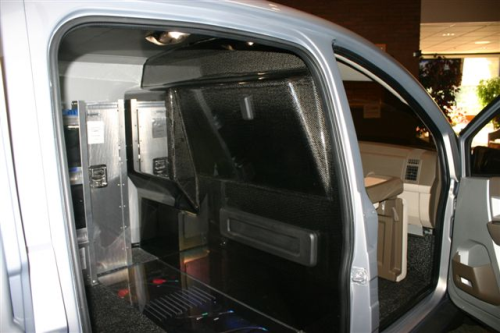
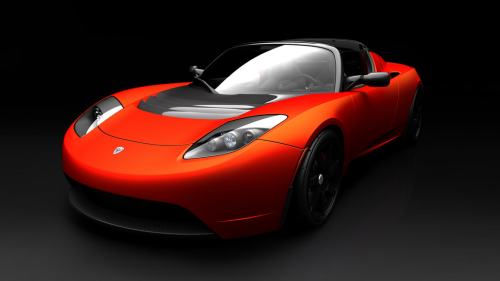
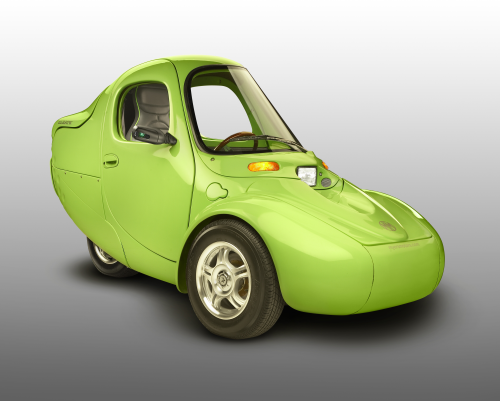
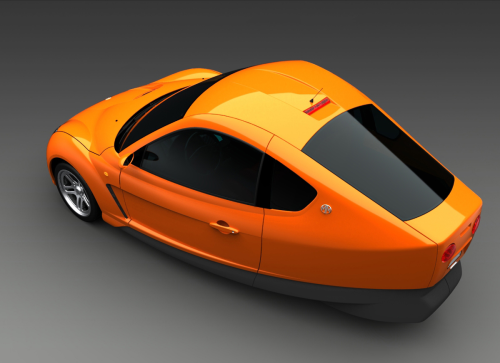
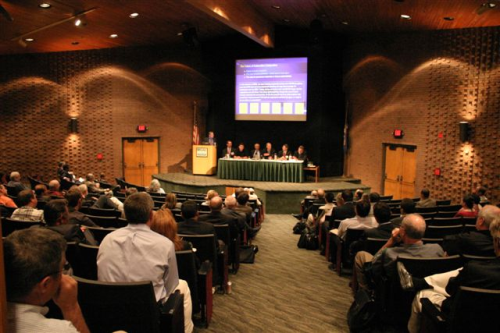
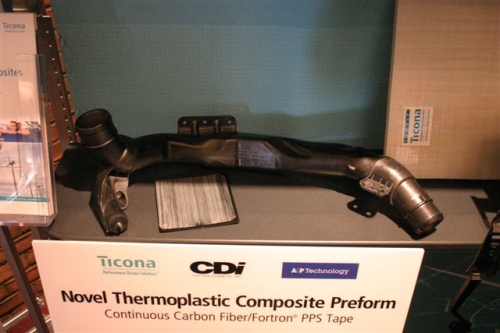
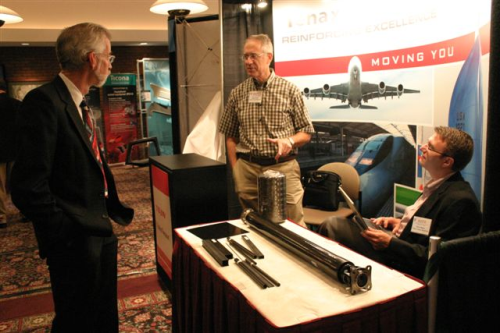
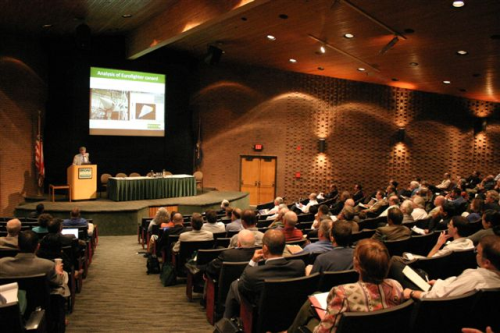
The title of the conference was Plug in … To Composites, and the mood and theme of the speakers and participants varied from the worst is over, to the last speaker summing up saying: “This is the best time for new polymer products since the 1980s!”
SPE decided to condense the conference from three days to two to aid busy participants. In his opening remarks conference chair, Cedric Ball, Ashland Inc, remarked that they feared the attendance would be low, but it inched up to the point where it was nearly equal to last year. The bad news we knew: from selling 16 million vehicles in North America, the auto companies were now selling 10 million. The financial mess has been in the news for a year. But what was the good news?
Some of the requests of the plastics engineers have been heard and answered. Conference participants had a history of complaining that, to automotive engineers, price was all that mattered and weight savings was secondary, if a consideration at all. The speakers made it clear that that has changed. The CAFE (Corporate Average Fuel Economy) standards to be passed shortly will probably call for 35.5 mpg for cars and 30 mpg for trucks. And this will drive downsizing and weight reduction. Finally!
At the same time the recession and the high price of gasoline have begun to change the public perception and they have shown the desire for smaller and/or more fuel efficient vehicles. Also, the emergence of electric vehicles and the extreme tradeoff between vehicle weight and battery requirements opens the door for lightweight composite materials.
Carbon fibre
While many composite materials have exhibited lighter weight and have steadily increased their list of automotive applications, no class of composites can touch the properties of carbon fibre reinforced plastic composites. The price and availability of carbon fibre for carbon fibre composites continue to be the big question.
Kalyan Sehanobish, Dow Chemical, began with a tough assessment. He felt that powertrain changes were more effective than weight reduction. Further, the price of gasoline could well drop which will reverse the trend toward smaller cars.
On the other extreme Gary Lownsdale, Plasan Carbon Composites, came out of retirement because the next 10 years are going to show huge growth for carbon fibres and he wants to help make it happen. In between these two extremes were a variety of presentations and opinions.
In the exhibit area, sitting next to the two race cars, the Corvette and Viper, made with large amounts of carbon composite, was the new Bright delivery van which had a mostly aluminium body but used carbon fibre composites for several large structural pieces.
Sehanovish mentioned the disadvantages of using carbon composites: price and cycle time; with the advantages being lightweight, crashworthiness and styling ease. He estimated that in automotive, one pound (1 lb) in mass reduction is worth about US$3, in airplanes $250, and in spaceships $2500.
While he pointed out that vehicles were going to get lighter, changing the powertrains would result in much greater fuel efficiency gains. He suggested diesels, then hybrids, and then hybrid/diesels would obtain the biggest fuel economy advantages.
The three ways to get better fuel economy were reduced:
- tyre resistance;
- aerodynamic drag (during highway modes);
- and inertia (during city driving).
He predicted that by 2030 established goals will be achieved: the carbon fibres will be $4-5/lb in ample supply with a 2-4 minute cycle time. Aluminium and steel have almost reached their limit of physics while carbon fibre composites have much room for improvement in their future.
Carbon fibre composites were the indirect subjects of three new manufacturers.
Bright Automotive, while designing a new hybrid delivery van, employed a carbon fibre reinforced plastic bulkhead between the driver’s seat and the storage area in the rear of the van. The bulkhead is required by law to protect the driver from projectiles during unexpected vehicle movement. Normally vehicles add a bulkhead as an aftermarket addition. The Bright vehicle carbon composite bulkhead allows them to use the structural integrity of the bulkhead to remove weight and structure from the surrounding body and frame.
Tesla Motors produces an electric sports car but it is now planning to produce a five-seat electrically-powered sedan for half the price of the sports car.
Dana Myers, Myers Motors, had a one-seater on display and was going to introduce a two-seater very soon.
All three companies came to introduce their concepts and to ask for any solutions carbon fibre composite suppliers might be able to lend them.
Lightweighting discussion
The panel discussion centered around lightweighting and carbon fibre composite. Everyone agreed that with the new CAFE standards and the higher prices for gasoline, lightweight materials will be much more acceptable.
David Cole, Center for Automotive Research (CAR), was very optimistic, noting that one million new households were being created as youngsters grew to maturity and needed vehicles. Over-capacity that has plagued the industry for the last 10 years has been eliminated and the car companies should now be able to make a profit on small cars.
Tadge Juechter, GM, agreed, adding that more money is available for product development and implementation; and Jim DeVries, Ford Motor Co, said the time is right for new technology.
Cole warned that it will not be stability but constant change that will be the key to success.
All the panelists agreed that design and manufacturing will be more globally driven with American vehicle demand changing and as DeVries indicated US sales are looking like European sales now: fewer trucks, more cars. Four or five years ago there wouldn’t have been a Tesla Motors.
Mike Jackson, CSM, indicated there will be profitable and more available small cars but full-sized trucks will still have their place. DeVries added that consumers will still demand power in the trucks. “Why have pickup trucks that can’t tow?”
Everyone agreed that governments had to act to keep the auto companies in business. But the governments don’t want to be in the auto business any longer than necessary. Phil Sklad, US Department of Energy (DOE), said his agency’s projects are changing; they are working on forging new partnerships to work on carbon fibre manufacturing.
Barrie Dickinson, Tesla Motors, said new players are driven by environment and less traditional markets.
In the discussion of electric vehicles, the panelists were unanimous that lightweighting was key. Jackson speculated that people might lease rather than own the batteries, and when the vehicle is not in use, would tie the battery into the electric power grid to be drained during peak power demand times and then recharged during low demand hours. Cole agreed that consumers need to merge electric cars and the power grid, adding there must be some way to store electricity if you want renewable power to work. Unlike electric generation power plants, wind turbines cannot be forced to produce more power when demand is higher. Cole said that the 1990s were compressed natural gas (CNG) research focused; the 2000s pushed fuel cells; and now we have electric vehicles. Do we run the risk of electric vehicles becoming the fuel cells of the 2010s?
Sklad said DOE’s focus is hybrids and plug-in hybrids while Juechter commented that the US tends to latch onto a solution and this hurts other possible solutions.
On the subject of diesels, Cole indicated that the diesel engines are twice as expensive as the gasoline engines and had significant emission challenges, especially for nitrogen oxides (Nox). Further, diesel fuel is more expensive to refine than gasoline.
Gary Lownsdale, Plasan Carbon Composites, was the last keynote speaker and the most optimistic. He first got into plastics in the 1970s when his advisor at the University of Cincinnati (Ohio) told him there is no future in plastics. He spent a career proving his professor wrong. Moreover he said he came out of retirement, not wanting to miss the upsurge of carbon fibre composites that he thinks today’s market will generate. He feels those who are unsure about carbon composites are in the same place his professor was in 1970.
Thanks to Boeing there is an ample supply of carbon fibre now. Carbon fibre price has dropped by a factor of 10 in the last 20 years and will continue to decrease. Carbon fibre composite is used virtually everywhere: wind turbines, military, construction, as well as ground vehicles. The supply base is worldwide: Korea, Japan, China, and North America. And soon reclaimed fibres will be coming online. Non-PAN-based carbon fibres are getting closer to actuality.
Manufacturing cycle times in some industries are very long. But he has found that state-of-the-art cure times have been reduced considerably and in his studies are close to the 2 minute cycle times necessary for high volume vehicle production. The vehicle industry needs to remove 500 kg from every truck to meet CAFE standards and this will drive the demand for carbon fibre composites.
Lownsdale finished strong, saying: “The time is now. The tools are available, the people are ready. And by 2018 there will be wide use of carbon fibre composites on major high volume vehicles and they will have class A finishes.”
Modelling
Of course, carbon fibre composites were not the only story told at the conference. The vast majority of composite parts are still manufactured with glass or other fibres/fillers and polypropylene or other polymers.
Eann Patterson, Michigan State University, introduced the University’s vision for a new technology centre whose charge would be to bridge the gap between universities’ basic research and manufacturers’ product development.
Another bright spot was the large number of papers on modelling. In the past, conference participants have called for more and better modelling to allow composites to compete with metals in concept-to-reality manufacturing.
Keynote speaker Hadrian Rori, Bright Automotive, pointed out that all the aerodynamic design for the Bright delivery van was done by computer (they hired THE Boeing engineer) and with no clay or scale models the first prototype agreed exactly with computer predictions.
Roger Assaker, e-Xstream Engineering, discussed the company’s software product, called DIGIMAT. Although this company is new (2003) its software has been well accepted and was used widely in the other modelling presentations. DIGIMAT is a non-linear micromechanical modelling technology that addresses the behaviour and failure of composites based on fibre content, orientation, and length.
Peter Foss, GM; Suresh Shah, Delphi Corporation; and Matthew Marks, SABIC, used DIGIMAT and ABAQUS softwares to predict, manufacture, and verify various composites. Foss warned about prediction problems in areas of extreme localised strain. All the presentations agreed that designers must use non-linear finite element analysis (FEA) because most simplifying assumptions result in unreliable property predictions.
Uday Sharma, University of Michigan-Dearborn, the 2008 SPE ACCE scholarship award winner, investigated the mechanical behaviour of woven fabric thermoplastic composites as did James Sherwood, University of Massachusetts-Lowell.
Uday Vaidya, University of Alabama, found dampening affects in long fibre reinforced thermoplastic (LFT) were related to fibre orientation and the dampening ability for composites was much better than aluminium. He used Boeing information indicating that vibrational frequency near failure produced much more useful information than just conducting the test to failure and he produced a model to use this information.
Other modelling papers dealt with prediction of various portions of the design and manufacturing processes: fatigue properties of glass fibre reinforced polyamide, performance of braided composites, damage analysis of LFT, mould clamping forces and stress distribution of resin transfer moulding (RTM), and fibre orientation in complex geometries using the discontinuous Galerkin finite element method.
Ellen Lackey, University of Mississippi, and Jay Tudor, Dow Automotive, spoke on the need and methods of developing proper standards and test methods for composite materials.
The bondline read-through (BLRT) question was addressed by Kedzie Fernholz, Ford Motor Co, and Hannes Fuchs, Multimatic, in two presentations on the study being done by the Automotive Composites Consortium, which continues to make progress. A number of examples were given.
Bio-based materials
Bio-fibres and bio-polymers were covered and as usual, Ford led the way, delivering both paper and keynote speech. The three motivations of using bio-based materials are:
- sustainability;
- competitive advantage based on weight, fuel consumption, and cost; and
- political drivers: reducing the dependence on foreign oil and access to potential government procurement programmes.
Deborah Mielewski outlined work to use more bio-based materials. The seat cushions for the Ford Mustang are presently using 12% soy-based foam made with a soybean oil based polyol. Ford solved the odour, fogging, and staining problems caused by small organic molecules present in soybean oil. Production will expand to many other platforms with projected use in 1 million vehicles.
While bio-based materials still hold promise, their lack of uniformity and lower strength hinder their wider application.
Enabling technologies
New additives, reinforcements and matrix enhancements were presented.
Nikhil Verghese, Dow Chemical, outlined a procedure to make thermoset epoxies more crack resistant. Thermoset epoxies have many good properties but a lack of toughness can cause catastrophic failures caused by crack propagation. He reported this could be improved by forming a block copolymer. By using one monomer with epoxy-phobic and epoxy-philic ends during polymerization, small elastomeric bubbles are formed which cavitate to prevent crack propagation. It has proven useful with wind turbines. However this won’t work with epoxies with very high crosslinking or high speed failure modes.
Gero Nordmann, BASF, reviewed a new acrylic thermoset based on water instead of organic solvents which produced no volatile organic compounds (VOCs), did not stick to the mould, and had very smooth surfaces. This formulation was new to the United States but has been used in Europe.
Zeba Farheen Abdul Samad, Universtiy of Illinois-Champagne/Urbana, 2009 SPE ACCE scholarship award winner, introduced a new aromatic thermosetting copolyester which displays liquid crystalline behaviour and has a thermal fatigue resistance better than epoxy.
Creig Bowland, PPG Industries, evaluated most of the coupling agents available on the market. Although he did not identify the coupling agent manufacturers by name, he did indicate that supplier terminology and maleic anhydride content nomenclature were not uniform and could be very confusing.
Frank Henning, Fraunhofer ITC, and Louis Martin, Adcomp, also produced test results using maleic anhydride coupling agents with polypropylene with an inline compounding system. They indicated their additive had no free maleic anhydride, which therefore reduced VOCs and odour inside vehicles using parts from this process.
Bob Eller, Robert Eller Associates, predicted the effects of the present recession and the anticipated recovery. His paper contained a large amount of information and he predicted that TP composites, especially LGF versions will benefit greatly by implementation of new resins, compound technology, and advances in fabrication technology.
Tom Russell spoke for Alan Murray, Allied Composite Technologies, about replacing steel with composites by using continuous oriented fibre reinforced thermoplastic impregnated tape. Polypropylene or PEEK with 55-70% glass is as strong as steel but not as stiff. By changing design, such as adding a foam core, stiffness can be improved to the point that it is better than steel.
Duane Emerson, Ticona Engineering Polymers, described a new part used in the two litre Jetta that received the Grand Award for Design in Europe. It is a combination of blow moulding and injection moulding for a turbo-charged diesel charge air duct. By using both blow moulding and injection moulding in the same process, they achieved a part which could replace a formed aluminium tube which had four welded brackets. Two of the injection mouldings took place on the blow moulding equipment and two injection mouldings took place on the hot blow moulded part. This is an excellent example of taking advantage of composites’ ability to form complicated parts in one step. Polyphenylene sulphide was used for its high temperature and solvent resistant properties.
Vehicles of the future
Paraphrasing author Charles Dickens – “This is the best of times; this is the worst of times” – the sentiment of the conference was to hope that the worst of the recession is over and reorganisation of the automotive industries have made them stronger and their future brighter. The composite industry is an essential partner, enabling them to make the fuel efficient and cost effective vehicles of the future.






